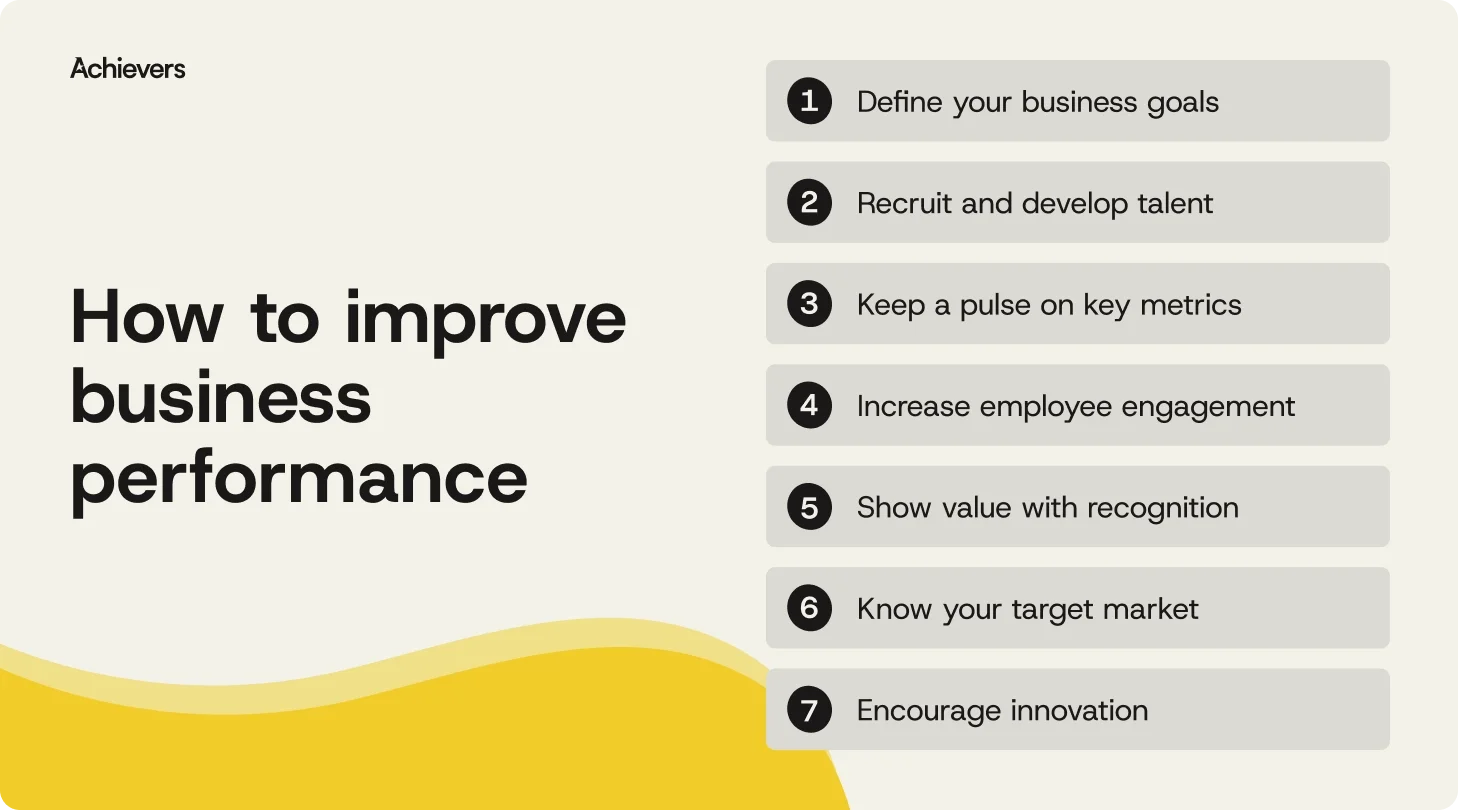Table of contents
Create a culture that means business™
Schedule a demo with an Achievers solution expert today.
Improving business performance sounds like a broad goal — because it is. Between shifting market conditions, budget pressure, and endless strategic options, it’s easy to get caught chasing short-term wins or spreading your efforts too thin. The real challenge? Figuring out which investments actually drive impact.
Here’s a hint: start with your people.
Recognition might not come with flashy dashboards or big-budget fanfare, but it works. In fact, companies using a dedicated recognition platform — like Achievers — are twice as likely to see measurable results compared to those running an in-house program, according to Achievers Workforce Institute (AWI) data.
The takeaway? Skip the guesswork. Focus on strategies that connect to your goals and your people — the ones backed by data, not just gut instinct. We’ve rounded up the smartest ways to improve business performance without losing sight of what keeps your company running: your workforce.
7 ways to improve business performance
Whether you’re looking to boost productivity, strengthen retention, or drive growth, these seven approaches can help you build a stronger, more performance-driven organization — without losing sight of what (and who) makes it all work.

1. Define your business goals
It’s hard to make progress if you don’t know what you’re aiming for. Clear, actionable goals keep everyone moving in the same direction — without the last-minute course corrections.
To define goals that drive real results:
- Involve your people: Use feedback tools to gather insights from every level of your organization — not just the C-suite.
- Let the data guide you: Use SWOT analysis and performance insights to shape SMART goals that are both ambitious and actionable.
- Create alignment across teams: When everyone’s rowing in the same direction, progress comes a lot faster (and with less churn).
2. Recruit and develop talent with the right skills and cultural fit
Performance isn’t just about what people can do — it’s about what they want to do. If employees aren’t aligned with your culture or your mission, even the best credentials won’t carry you far.
To build a high-performing team:
- Craft a compelling EVP: Show candidates what’s in it for them — and why your culture is worth joining.
- Hire for fit, not just function: According to the AWI Engagement and Retention Report, culture alignment is one of the top five ways to increase an employee’s emotional salary.
- Invest in growth: Ongoing learning and development send a clear message: we believe in your potential — and we’re backing it up.
3. Keep your finger on the pulse of key metrics
You can’t improve what you don’t measure. And while revenue and profit matter, they don’t tell the whole story. Employee performance, engagement, and well-being often signal the health of your business before the numbers hit your dashboard.
- Track what really matters with the right tools: Use KPIs and performance dashboards to make faster, smarter decisions — and flag what needs attention before it becomes a problem.
- Look beyond the basics: Monitor recognition frequency, manager effectiveness, and burnout indicators to get a fuller picture.
- Act on insights: Data is only useful if you do something with it. Build a habit of closing the loop.
4. Increase employee engagement
Employee engagement gets dismissed as fluff until you see what a fully engaged team can do. More ideas, more hustle, and a lot less turnover.
Here’s how to fuel it:
- Recognize what matters: Frequent, meaningful recognition is one of the strongest drivers of engagement, according to AWI research.
- Listen often — and early: Use engagement tools to surface issues before they spiral into turnover.
- Enable action planning: Equip managers to build action plans with their teams, not for them. It’s about shared ownership, not top-down mandates.
5. Show team members they’re valued with employee recognition
People won’t give their best if they don’t feel seen. Skip the plaques and pizza parties. Real recognition drives behavior, builds loyalty, and keeps your culture from cracking under pressure.
To get recognition right:
- Go beyond birthdays and tenure: Look for a platform that makes recognition easy, social, and frequent.
- Make it meaningful: Tie recognition to your values and goals so it reinforces the behaviors you want more of.
- Choose a platform built for scale: Achievers’ recognition platform helps companies deliver real-time, global recognition experiences that are aligned to business outcomes — not just feel-good moments.
6. Know your target market
If you’re trying to sell to everyone, you’re not really selling to anyone. Clear audience insights help you prioritize your efforts and tailor your offerings to the people who actually want what you’re building.
To sharpen your focus:
- Gather customer and employee insights: Your front-line teams know more than your CRM does. Use surveys and employee feedback tools to tap into that.
- Ask better questions: What pain points are your customers navigating? What solutions are they willing to pay for?
- Tweak, test, repeat: Use those insights to fine-tune what you’re offering. The best businesses stay a step ahead, not a step behind.
7. Encourage innovation and adaptability
Hitting targets is great. But teams also need the freedom to rethink how those targets get hit — especially when priorities shift (and they always do). When employees feel trusted and supported, they’re more likely to speak up, try new approaches, and roll with change instead of resisting it. A culture that values curiosity and experimentation will help you get ahead, instead of just keeping up.
To build that kind of culture:
- Give people room to experiment: Innovation doesn’t happen in a vacuum or under micromanagement. Let teams test ideas, learn from what works, and adjust without fear of failure.
- Keep a pulse on what’s changing: Trends, tools, expectations — they can all shift at any given moment. Make it a habit to stay on top of what’s changing and share insights across the business.
- Equip teams to flex, not freeze: When change shows up, teams need clarity, communication, and permission to adapt. Agility isn’t a soft skill — it’s a business skill.
The business results of improved performance
When team performance levels up, so does everything else. From revenue to retention, the ripple effects are real, and they’re measurable. Focusing on performance doesn’t just make work better; it makes the business stronger.
Here’s what that looks like in practice:
Revenue growth
When employees are engaged and energized, the bottom line tends to follow. Motivated teams sell more, serve better, and find ways to innovate — all of which drive revenue.
Add in better decision-making and smoother operations, and performance becomes a growth engine, not just a goal. Prioritize performance, and you’re setting the business up to grow and get smarter as it does.
Employee retention
People stick around when they feel connected — to the work, the culture, and the mission. High-performing teams aren’t just more productive; they’re more invested.
When employees see real opportunities to grow, engagement rises — and turnover rates drop. That means fewer hiring headaches, lower training costs, and a stronger, more stable workforce to carry the business forward.
Increased productivity
High performance is about working smarter, not harder. When people know what matters (and why), they waste less time, make faster decisions, and get more done.
Performance-driven teams are better at prioritizing, problem-solving, and spotting ways to streamline the day-to-day — which adds up to serious impact, without the burnout.
Customer satisfaction
There’s a direct line between employee performance and customer experience. When teams are engaged, they show up differently — with more care, more energy, and more pride in the outcome.
That leads to better service, stronger relationships, and loyal customers who keep coming back (and bring their friends).
Optimized costs
Performance improvements aren’t just about output — they’re also about efficiency. When people are aligned and motivated, they naturally cut down on wasted time, duplicated effort, and avoidable mistakes.
The result? Leaner operations, smarter resource use, and savings that can be reinvested into growth — instead of getting lost to inefficiency.
Improve business performance by engaging your employees
When employees are engaged, motivated, and recognized, performance isn’t just better — it’s more sustainable. But real impact starts with understanding what drives your people and giving managers the tools to act on it.
That’s where Achievers comes in.
With a workforce science-backed recognition platform like Achievers, you can turn recognition into a daily habit — one that reinforces key behaviors, strengthens culture, and fuels real business results. And with built-in analytics, it’s easy to see what’s working and where to focus next.
Better performance starts with better engagement. Let’s make it happen.



